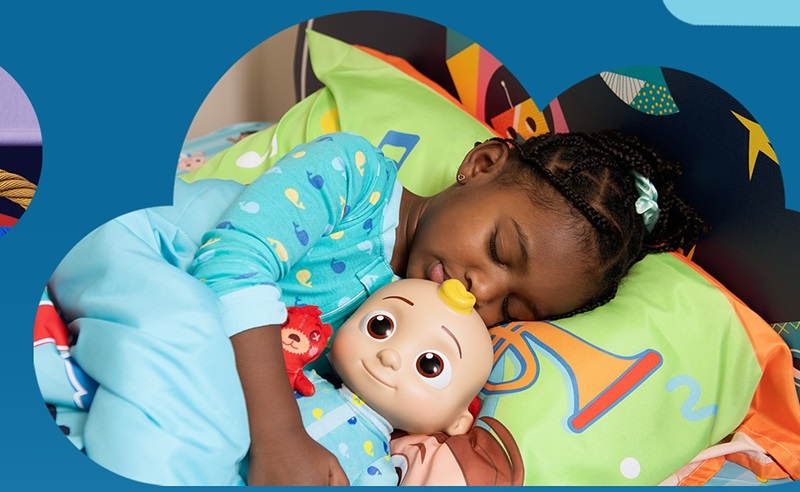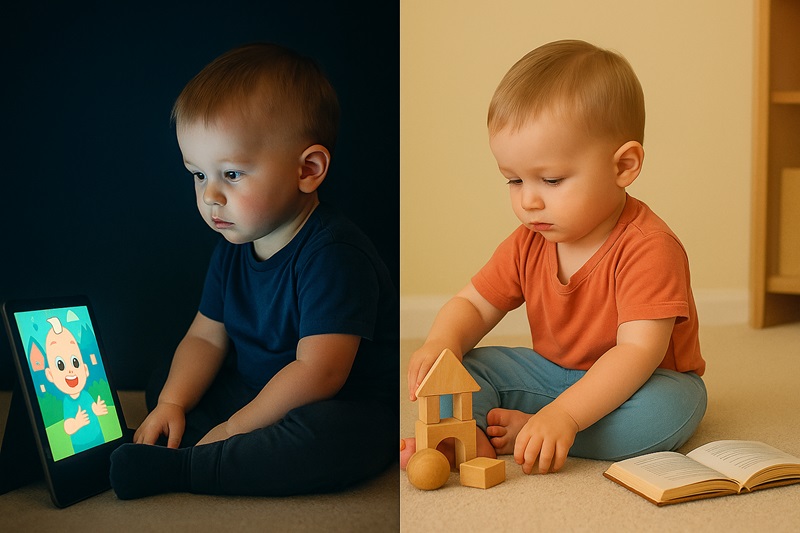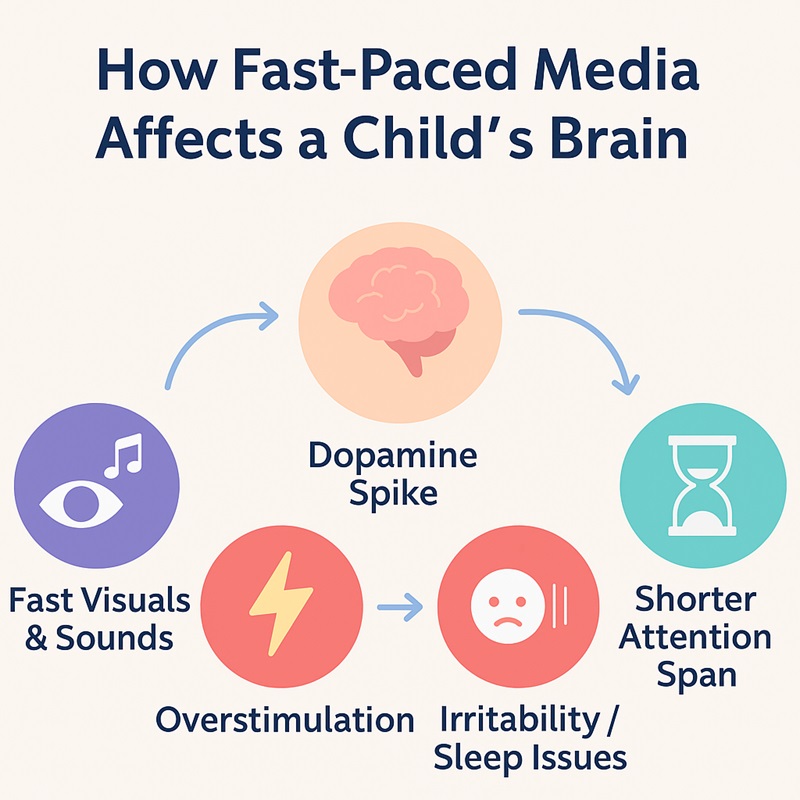Quick Answer (Is Cocomelon Bad for Kids)
Cocomelon isn’t inherently bad for kids, but its rapid visuals and non-stop sensory input can overstimulate developing brains. Experts say the show’s quick scene cuts and constant music may affect attention span, focus, speech, and emotional balance in toddlers—especially with long, unsupervised screen time.
Is Cocomelon Really Bad for Kids’ Brains?
If you’re a parent in the U.S., chances are Cocomelon has played in your home more than once. The cheerful songs, colorful animations, and smiling characters seem harmless—maybe even educational.
But beneath the catchy tunes, many parents are asking a serious question: Is Cocomelon bad for kids’ brains?
As child psychologists and pediatricians study how fast-paced shows affect young minds, the answer reveals more about how children’s brains process modern media—and why screen moderation matters more than ever.
The Rise of Cocomelon and Why Parents Love It
Few children’s shows have become as instantly recognizable as Cocomelon. Originating on YouTube and later expanding to Netflix, it has become a household staple for millions of U.S. families.
Its short, rhythmic songs, bright colors, and familiar family themes make it feel safe, engaging, and even educational.
For busy parents, Cocomelon often feels like a “lifesaver”—a few minutes of quiet while preparing dinner or finishing chores. The songs teach counting, colors, and daily routines, so it feels productive.
But many parents began noticing something odd: tantrums when the show stopped, shorter attention spans, and difficulty enjoying slower activities like reading or puzzles.
That’s when the question started trending online—is Cocomelon overstimulating young brains?
What Makes Cocomelon Different from Other Cartoons
Not all kids’ shows affect young minds in the same way.
Compared to calm programs like Bluey or Daniel Tiger’s Neighborhood, Cocomelon moves much faster and keeps the senses busy almost all the time.
Key Differences:
• Fast scene changes: The screen shifts every one or two seconds.
• Constant music: There is almost never a quiet moment.
• Bright colors and motion: The bold, high-contrast animation grabs attention—but can also tire young eyes and minds.
Cocomelon’s nonstop pace keeps children watching, but it also challenges their ability to pause, process, and relax between scenes.
| Show | Average Scene Change | Tempo | Expert Rating for Calm Engagement |
| Cocomelon | 1–2 seconds | Very fast | Low |
| Bluey | 4–6 seconds | Moderate | High |
| Daniel Tiger | 5–8 seconds | Slow | Very High |
This fast pacing gives kids’ brains little time to rest or process what they see, conditioning them to expect continuous stimulation.
How Fast-Paced Cartoons Affect a Child’s Brain
During the early years, a child’s brain is growing fast. It is building billions of new connections that help with focus, attention, and emotional control.
When screen content moves too quickly—with flashing lights, loud music, and constant motion—the brain reacts with quick bursts of dopamine, a chemical linked to excitement and reward. Over time, the brain may start to crave fast stimulation.
Possible Effects:
• Shorter attention span
• Restlessness or frustration when screens stop
• Trouble focusing on real-world play or learning
• Weaker emotional control
A study in Pediatrics (Lillard & Peterson, 2011) found that just nine minutes of a fast-paced cartoon hurt preschoolers’ ability to plan and focus compared to a slower show.
Experts at the Harvard Center on the Developing Child say children learn best when life has predictable rhythms and pauses. These quiet moments help the brain build self-control—something fast shows like Cocomelon rarely allow.

Does Cocomelon Affect Speech Development?
Speech and language skills grow through back-and-forth interaction—eye contact, imitation, and conversation.
Fast-paced shows like Cocomelon can unintentionally delay this growth when they replace meaningful dialogue with passive listening.
What Experts Observe:
- Kids may sing along but not practice real conversation.
- The nonstop narration and songs leave no space for response.
- Overstimulation can reduce focus on slower, natural speech patterns.
A study in JAMA Pediatrics found that toddlers exposed to high screen time before age three often showed delayed expressive language.
Speech therapists note that some children repeat phrases from Cocomelon (a behavior called echolalia) without understanding their meaning.
How Parents Can Support Speech Growth:
- Talk about what’s on screen: “What color is JJ’s shirt?”
- Narrate your child’s daily activities to reinforce natural language.
- Use Cocomelon songs as prompts for real-world learning (e.g., singing while washing hands).
Is Cocomelon Bad for Kids with Autism or Sensory Issues?
Children with autism or sensory sensitivities often experience sights, sounds, and emotions more strongly than others.
Cocomelon’s bright colors, quick scene changes, and layered sounds can sometimes feel too intense for them.
Why It Can Be Hard:
• Too much to see: Fast color changes and quick cuts can make it tough to focus.
• Too much to hear: Songs, voices, and background sounds play all at once.
• Strong emotions: Big facial expressions and loud music can cause stress or anxiety.
Therapists say some children on the spectrum may get stuck on Cocomelon, repeating words or having a hard time stopping when the show ends. While repetition can feel safe, too much screen time may make it harder for them to interact or shift to new activities.

Parent Tips for Sensory-Sensitive Kids:
• Watch together and talk about what’s happening on screen.
• Lower the brightness and volume to make viewing calmer.
• Try gentler shows like Bluey, Little Bear, or StoryBots.
• Balance screens with hands-on play—sand, water, clay, or music.
Every child is unique. The goal isn’t to ban screens, but to notice what triggers stress and keep a healthy balance between screen time and real-world play.
Signs Your Child Might Be Overstimulated
If Cocomelon or other fast-paced shows are part of your child’s daily routine, it’s helpful to notice patterns that may mean their brain is getting too much stimulation.
Here are some common signs — and what they might mean.
1. Trouble Focusing on Toys or Books
After watching high-energy shows, some kids find it hard to enjoy quiet play.
They may lose interest in puzzles, drawing, or storytime after only a few minutes. Their brain gets used to fast changes and nonstop excitement.
If this happens often, plan screen-free time before quiet play so they can refocus and calm down.
2. Tantrums or Meltdowns When Screens Turn Off
If your child cries or screams when the show ends, it may mean they rely too much on digital excitement.
Fast-moving shows release dopamine, a “feel-good” chemical in the brain. When that stimulation stops suddenly, frustration can follow.
Try to transition slowly—give a warning before screen time ends and move into a hands-on activity like blocks or play-dough.
3. Restlessness or Hyperactivity After Watching
Some children seem full of energy after watching Cocomelon, but this isn’t calm energy—it’s a stress response.
Bright visuals and loud sounds keep the body alert even after the show stops.
Help them reset with calm play: go outside, stretch together, or read a short story.
4. Trouble Falling Asleep or Calming Down
Bright screens and loud sounds can block melatonin, the sleep hormone.
Kids who watch stimulating shows near bedtime may toss, turn, or wake up during the night.
Use a “screen wind-down” rule—no screens for 30 to 60 minutes before bed. Replace cartoons with quiet music or bedtime stories.
5. Choosing Screens Over People
If your child always picks a screen instead of talking or playing, it may show that screen time feels easier than real interaction.
This can slow language growth, social bonding, and confidence.
Plan tech-free family times where you play, talk, and make eye contact together.
Parent Tip
After screen time, switch to calm play like drawing, reading, or music.
If your child becomes upset or struggles to switch activities, that’s a clear sign of overstimulation. It’s your cue to slow down screen exposure and bring more balance into their day.
How to Make Screen Time Healthier
You don’t have to ban Cocomelon—you just need to guide how it’s used.
✅ Expert Tips:
• Limit total screen time: The American Academy of Pediatrics (AAP) suggests no screens under 18 months (except video calls) and less than one hour per day for ages 2–5.
• Watch together: Sit with your child and talk about what’s happening on screen. Connect the story to real life.
• Mix in real play: Outdoor time, pretend play, and hands-on games help kids build focus naturally.
• Pick calmer shows: Bluey and Daniel Tiger’s Neighborhood move slower and support emotional learning.
Should Parents Ban Cocomelon?
Not necessarily. Think of it like sugar—a little is okay, but not too much.
Cocomelon can help kids learn songs, routines, and social skills. But if it replaces real play or conversation, it becomes a problem.
If your child seems overstimulated or depends on screens to calm down, take a short break from Cocomelon. Many parents notice better focus, sleep, and play within a week.
Key Takeaways for Parents
- ⚡ Fast-paced shows like Cocomelon can overwhelm young brains.
• ️ Too much screen time may slow speech and shorten attention.
• Kids with sensory issues or autism may find it stressful.
• Co-viewing and moderation work best.
• Balance screens with calm, creative, and social play.
The goal isn’t to ban Cocomelon—it’s to help kids enjoy screen time in ways that support calm, learning, and real connection.






